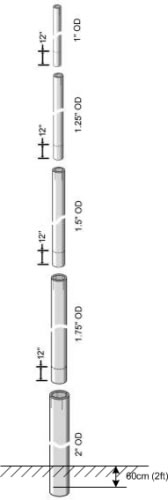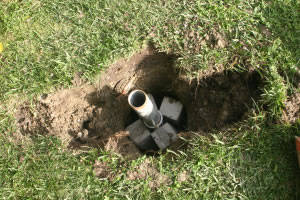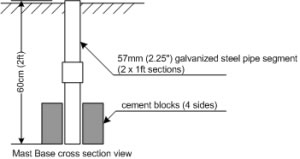Mission Viejo Special, The Multiband Vertical (#3 of 6)



Construction
While I do not call it exactly “low cost”, the overall cost of building antenna is substantially less than many of the store-bought trap vertical. Below is the material and scheme I used to build this antenna. It represents one way, but by no means only way to build it. Try out your ideas.
Mast / Mast Base
First, the most important ingredient: fiberglass tubing mast. I used DXE-FTK50 50 ft Fiberglass Tubing Kit from DX Engineering. This is the majority cost of this antenna. It consists of seven fiberglass tubing of 2.44m each (OK, so they are 8’ each) and band clamp for each connection. If you allow 60cm overlap at each stage, it gives 16.5 meter (all right, 50 feet) length mast, with 52 mm OD at the bottom, 12.5mm at the top.
But you only need about 10 meter length, so only five stages are needed, making the 25.4mm OD at the top. Why buy 50 feet kit? Because it’s cheaper to buy the kit than buying five tubings separately.
By limiting the top OD to 25.4mm, the structure is fairly rigid so it can be self-supporting, but light enough that one man can erect it.
Nonetheless, it is difficult to lift and set in the base if extended at full length, so I slid in the top 3 tubing and let it stand at the base, then push up each stage to the full length. It is important to mark each tubing 60cm from bottom as the “stop marker”.
The construction of mast base (English translation: digging a hole for the mast) takes the most amount of work. It would be best if you create a cement base, but I thought that makes the setup “too permanent”, and that was not a good idea for someone who is experimenting with ideas often. So I took more “temporary” approach. But if it’s done right, it is sturdy. The approach mentioned here is just one idea; there are other great ideas, too. Yours. Try it.
I picked up a piece of galvanized pipe, 54mm (2 ¼”) inner diameter, 60cm (2’) long at Home Depot, and bury that in a 60cm hole You must dig that hole. The hole must be large enough to bury several “cement dobies”, also picked up at Home Depot. The dobies are small cement blocks with good weight, so burying them right along with the steel pipe in such a way to support it from the side, it makes a good enough base for a light vertical antenna. Care should be taken that the pipe is pointing perpendicular from the ground, so the mast didn’t end up being a “leaning tower of Mission Viejo”. Once the pipe and dobies are in solid, bury them, stomp on them hard to make sure the soil is nicely packed around it.
| Ü | Introduction | Þ | |
| Specification | |||
| Theory | |||
| Mast, Base | Radial Plate | Boom | Elements |
| Grounding | UNUN | Tuner | Adjustment |
| On The Air | |||